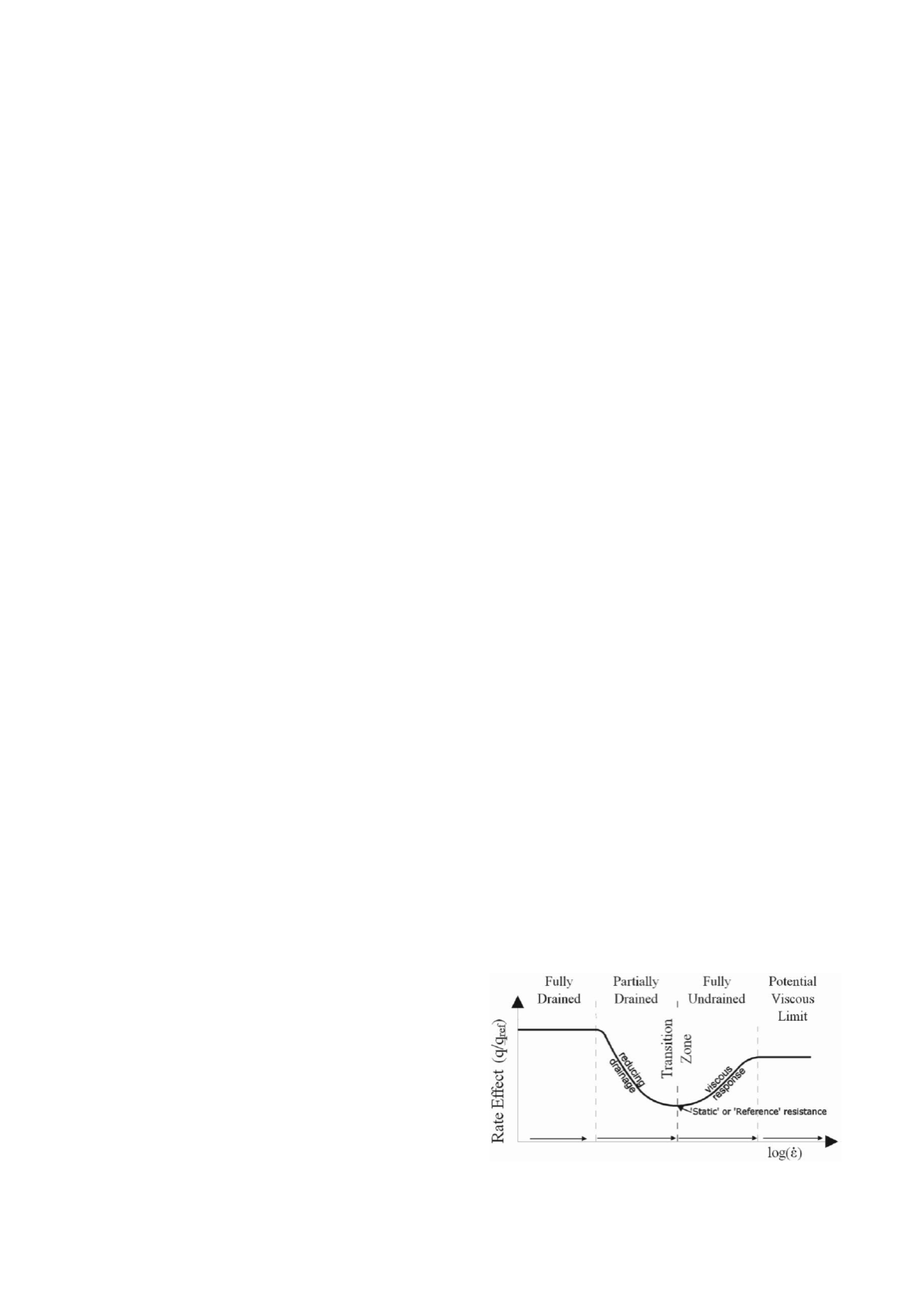
263
Proceedings of the 18
th
International Conference on Soil Mechanics and Geotechnical Engineering, Paris 2013
1
Rate effects at varying strain levels in fine grained soils
Effets de vitesse de déformation à niveaux de déformation variant en sols à grains fins
Robinson S., Brown M.J.
Division of Civil Engineering, University of Dundee, Dundee, Scotland, UK.
ABSTRACT: There is a need for an improved understanding of rate effects over a wide range of strain rates in order to improve the
modelling and analysis of high strain rate activities. Using triaxial testing on reconstituted kaolin over a wide strain rate range this
paper examines the impact of strain rate on the aspects of soil response which are important in many areas of geotechnical
engineering. It is demonstrated that shear strength, small strain stiffness and the elastic shear strain threshold are rate dependent.
RÉSUMÉ : Il est besoin pour une meilleure compréhension des effets la vitesse de déformation sur une grande gamme de vitesses de
déformation en vue d'améliorer la modélisation et l'analyse des activités à vitesses de déformation haute. Par l'utilisation tests
triaxiaux sur kaolin reconstitué sur une grande gamme de vitesses de déformation, présent document examine l'impact de vitesse de
déformation sur les aspects de réponse du sol qui sont importants dans nombreux domaines d'ingénierie géotechnique. Il est démontré
que résistance au cisaillement, rigidité à faible déformation et seuil de déformation élastique sont dépendant la vitesse de déformation.
KEYWORDS: rate effects, strain rate, strain level, small strain, elastic strain threshold, shear modulus, dynamic tests, triaxial, kaolin
1 INTRODUCTION
Rate effects are an important consideration in many areas of
geotechnical engineering as they influence the strength and
stiffness of the soil, however, the impact of rate effects is
difficult to determine and analyse. Because of this, there is a
need for a better understanding of rate effects and how they
influence soil response.
One aspect that requires further study in order to achieve this
is the relationship between rate effects and strain level, as this
varies throughout the course of geotechnical activities. Being
better able to consider rate effects throughout the entire strain
range raises the opportunity to improve both accuracy and
efficiency.
This paper considers the strain-rate dependence of rate
effects over a wide range of strain magnitudes at shear strain
rates from 0.333 to 60,000 %/hr.
1.1
The influence of strain rate
The most commonly used assumption in terms of rate effects is
that of Kulhawy and Mayne (1990) which states that for every
log cycle (tenfold) increase in strain rate, a ten percent increase
in shear strength is expected. However, this has been shown to
be variable, with the rate effects observed ranging from 9.5 to
20 % (Bea 1982). Another key consideration is that this
assumption does not consider any variation of rate effects with
strain level (Brown 2009), as it is based on a correlation using
only peak shear strengths. Similarly, only undrained testing was
used, meaning that the impact of drainage on the determination
of the rate effect was not dealt with.
Drainage effects are significant as the strain rate influences
whether there is time for drainage to occur. This means that rate
effects tend to follow a “U-shaped” curve as shown in Figure 1.
At extremely slow rates, there is time for pore pressure
developed during shearing to fully dissipate. As the strain rate
increases, the reducing time for drainage means that increasing
pore pressures and hence lower shear strengths are observed in
the partially drained region. As the strain rate is increased
further, the soil response becomes almost fully undrained,
where pore pressures are at their maximum. After this point,
viscous effects cause the observed shear strength to increase
with strain rate up to a potential viscous limit (Chow and Airey
2011). The form of this shear strength-strain rate relationship
has been verified by studies using a wide range of test methods
from cone penetrometer testing to large scale shear boxes.
(Steenfelt 1993, Lehane et al 2009)
Shibuya et al (1996) showed that the initial small strain
stiffness,
E
max
, is rate independent and constant for the range of
strain rates investigated (0.6 to 84 %/hr). It was also found that
this linearity continued up to a strain defined as the elastic strain
threshold,
ε
EL
, which was itself rate dependent, increasing with
increasing strain rate. These findings were confirmed by
Mukabi and Tatsuoka (1999).
Lo Presti et al (1996) found that soil stiffness is rate
independent below 0.001 % shear strain, and increases with
strain rate beyond this point. To allow comparison of relative
stiffnesses at different strains and strain rates, Lo Presti et al
(1996) defined the strain rate coefficient,
α
.
There are numerous geotechnical applications where rate
effects are an important consideration, including free falling
penetrometer tests where velocities can reach up to 12 m/s
Figure 1. U-shaped curve showing the idealised variation of rate effect
with strain rate (Quinn and Brown 2011)


